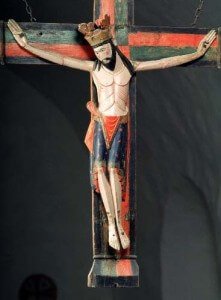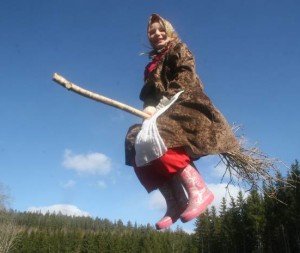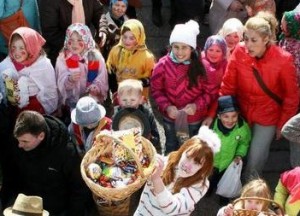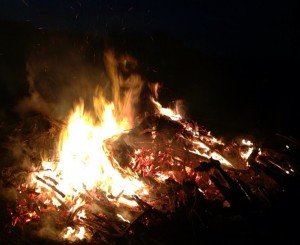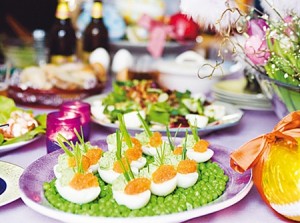| Fat Tuesday | Waffle Day | Easter | Walpurgis Night | Mother’s Day |
| Midsummer | Halloween | Lucia | Christmas |
Easter (Sw. påsk, pronounced ”poh-sk”) is the foremost holiday in all Christian countries. Considering that Swedes, compared to most other nationalities, are a very secularized people, one can wonder how Easter is celebrated in Sweden. Do Swedes celebrate Easter at all? Yes, we do, but… the most common celebrations have their origin not in Christian mythology but in native superstition and folklore.
Still, we have a Christian history (and at least some Swedes attend church services during Easter… well, quite a few, actually). At least, our Christian history has left traces in the names of the holidays.
It may not be very likely, but in case you should find yourself discussing holidays with a Swede, you’d be better off if you knew about the funny day names in Stilla veckan (”Silent Week”), so let’s start with that, before we look into how Easter is celebrated in Sweden:
The days of the Holy Week
Blåmåndag, translating to ”Blue Monday”, is a commonly used Swedish name for Shrove Monday. This day has also, for unknown reasons, been known as Fläskmåndag (Pork Monday) or Korvmåndag (Sausage Monday). Maybe these were the original names, because the real Blåmåndag is actually the Monday before Lent… Why the name lately has migrated six weeks forward is yet one of the Easter mysteries.
Vita tisdagen means ”White Tuesday”. Like the previous name, this one has also migrated six weeks closer to spring: Vita tisdagen is originally another name for Fat Tuesday. Misunderstandings do happen.
Dymmelonsdag is the true name of the third day. It’s a weird name. The second part of the word, onsdag, means Wednesday, but the first part? The word dymmel is very old, quite archaic, probably with the same origin as the English word ”dumb” meaning ”mute”. The day got it’s name from the custom to dampen the sound of the church bells for the rest of the week by capping them with cloth or felt and exchange the bronze clapper with a wooden clapper.
Skärtorsdag is Maundy Thursday. This is also a funny word: in modern Swedish, ”skär” can mean the color ”pink” or the imperative ”cut”, but of course that’s not what it means here. It’s as archaic as the previous name and means ”purge” or ”clean”. It refers to the story about Jesus washing the disciples’ feet before the last supper. (But I bet that at least some in the younger generation think it means Pink Thursday – that would fit in nicely with Blue Monday and White Tuesday…)
Långfredag – you have already guessed it – means ”Long Friday”. To me, this seems more appropriate than the English name, Good Friday, at least in a Christian perspective.
The meaning of Långfredag is almost palpable to Swedes of a certain age: before 1969, no shops, restaurants, theatres – actually nothing – was allowed to be open on Långfredag. Everything was closed. The town seemed dead. There were only two TV channels, one showing church service, the other a documentary on shards of Etruscian clay pots. This day had to be filled with Ludo, Monopoly, or Solitaire, and Långfredag really seemed to be long, endless. Today, those interdicts are broken, and Långfredag is a ”red day” in the calendar, which means that most people are free from work and can frolic in shops, restaurants and entertainment.
Påskafton means just that: Easter Eve. True to the Swedish tradition to celebrate any given holiday on the day before the holiday, Påskafton is the day when Swedes celebrate Easter. (Swedes celebrate Christmas on Christmas Eve, Whitsun on Whitsun Eve, Midsummer on Midsummer Eve, and so on… maybe because that way, you can use the real holiday to tend your hangover?)
Påskdagen is of course Easter Sunday.
Annandag Påsk (Easter Monday) would in modern Swedish be called Andra Påskdagen, which translates to ”the second day of Easter”. It’s a red, work-free day.
No products found.
Traditional Easter Celebrations
Godis! (candy, goodies)
Easter is an orgy in candy, chocolates, and toffee, delivered to the kids in large brightly colored påskägg, i.e. eggshells of cardboard, plastic or sheet metal; the bigger, the better. That is, kids are constantly sugar-speeded from skärtorsdag until late on påskafton, when the påskägg usually is empty and replenishment from their exhausted parents is unavailable.
In contrast to USA, children in Sweden usually do not believe that the eggs have been laid by the Easter Bunny, even if pictures of a bunny are common on their påskägg.
Påskris (~ Easter twigs)
If you haven’t done so already, skärtorsdag is the day when you cut thin twigs of birch and put in a vase, decorated with feathers or down of bright color.
Cutting birch twigs on skärtorsdag has its origin in the 17th century, preparing tools for flogging one another on the morning of långfredag to commemorate Jesus’ suffering. The flogging habit died several centuries ago, but the custom to take in birch twigs survived. The idea to beautify the whole thing with brightly colored feathers is however imported from Germany, as late as in the early 20th century.
Häxor (witches)
Skärtorsdag is the day when witches supposedly travel to Blåkulla (~Blue Hill) to have intercourse with the devil before returning on the night before Easter Sunday. The place Blåkulla seems to exist only in mythology, even if some people mean – probably because of the name similarity – that Blåkulla is the island Blå Jungfrun (~the Blue Virgin) in the Baltic Sea. In popular belief, the witches make the journey riding on broomsticks, and on their way they’ll try to snatch children in order to present them to the devil.
This myth seems to have been formed in the 16th and 17th centuries. It was the time of witch trials, when thousands of people all over Europe (mostly women) were accused of collaboration with the devil, sentenced and burned at the stake. This gruesome business was common in most Catholic European countries, where some 30,000 women were executed after show trials, but it occurred also in Protestant Sweden, albeit less frequent.
Påskkäringar and Påskbrev (~witches and Easter letters)
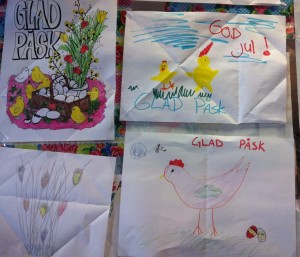
The original etymological meaning of the word käring is actually a dear person, ”a loved one”, but in today’s vernacular, käring means ”old woman”. And a påskkäring is a witch.
Anyway, a new habit was formed some 150 years ago, inspired by the waning belief about witches: children started to dress up as påskkäringar and distribute their own drawings in the neighbourhood, called påskbrev (~Easter letters).
This custom varies across the country: in the beginning, it might have been performed like the original procedure for giving julklappar (Christmas presents), i.e. knock on the door, throw in the object, close the door and run. This original procedure is still in use, among other places, in the rather rural western part of the province Värmland, and the påskbrev is filled with candy – i.e. it’s a gift to one’s friends.
Sadly enough, this commendable procedure has deteriorated in the cities, where kids made up as påskkäringar roam around offering pre-printed påskbrev to everybody in the neighbourhood, claiming godis in return. Just like Halloween… sigh.
Påskparad (Easter Parade)
An Easter Parade is arranged on skärtorsdag in some cities, after a modified American concept, with children dressed and painted as witches. In many cities, however, the parade takes place on påskafton.
The parade usually ends with a godisregn (candy rain).
Påskbrasa (Easter bonfire)
To scare witches away, the people used to light up påskbrasor, i.e. large bonfires. This custom is still common in the southwest part of Sweden, in particular in the province of Bohuslän, but is nowadays usually performed on Saturday instead of Thursday (makes you wonder, don’t they want their children back?).
Lately, this custom has taken on big proportions, creating problems on the islands outside of Gothenburg, where people have discovered that old Christmas trees make excellent bonfires. (Have you seen a dry spruce burn? The intensity is next to explosive.) People are competing for the biggest fire and are even raiding neighbouring villages and suburbs to steal their old Christmas trees. The bonfires have grown to a size that the fire brigade is needed to keep them under control, and local governments have to issue decrees of when, where, and how fires are allowed.
(Bonfires are still popular elsewhere and everywhere in chilly Sweden, but today the phenomenon is more common on Walpurgis Night, with speeches about spring, male choirs and general singalong.)
Påsksmällare (fire crackers)
In parallell to the bonfires, firecrackers used to be popular on påskafton, but after numerous accidents and intense propaganda from local authorities, this habit seems to be receding.
Äggpickning (egg pecking)
In the province of Skåne, in the southmost part of Sweden, äggpickning is a traditional game on the morning of Easter Sunday.
The object of the game is to crack the opponent’s egg. Contests are held in many places, most reknown on the pier in Simrishamn. Each contestant has to bring a painted hard-boiled egg. An umpire scrutinizes the contestants’ eggs to make sure they are real eggs, before the game can begin.
It’s a real knockout contest: the eggs are knocked against each other, tip against tip, until one breaks and loses. The winner gets the loser’s egg and goes on to meet next contestant. Finally there’s only one egg left intact, and the winner has enough eggs to feed all of his family and neighbours.
Food and drinks
Like anywhere in the world (?) Easter is associated with eggs also in Sweden, so egg dishes are of course a must on this holiday.
Påskbordet, served on Easter Eve, is basically a version of the classic Swedish smörgåsbord, with the restriction that at this time of year, it must offer eggs prepared in several ways, and it must also offer a number of salmon dishes (cold cmoked, hot smoked, cured, baked, boiled…). The inlagd sill (pickled herring) is inevitable (yummy!), and over that, there is usually a selection of meatballs, sausages, pates and quiches.
Children drink påskmust (~”Easter sap”), a dark brown carbonated beverage flavored with secret ingredients (this is actually the same beverage as served at Christmas under the name of julmust). Adults usually drink beer and akvavit (except designated drivers, who of course will have to make do with påskmust).
Dinner on Easter Sunday is often a lamb steak, and to start with, there is usually a lot of leftovers from from the day before.
